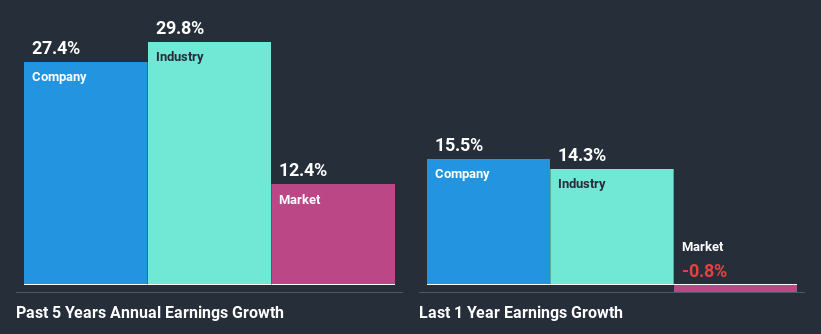Is Microsoft Corporation's (NASDAQ:MSFT) Stock's Recent Performance A Reflection Of Its Financial Health?
Microsoft's (NASDAQ:MSFT) stock is up by 5.7% over the past three months. Since the market usually pay for a company’s long-term financial health, we decided to study the company’s fundamentals to see if they could be influencing the market. Particularly, we will be paying attention to Microsoft's ROE today.
ROE or return on equity is a useful tool to assess how effectively a company can generate returns on the investment it received from its shareholders. In other words, it is a profitability ratio which measures the rate of return on the capital provided by the company's shareholders.
View our latest analysis for Microsoft
How Is ROE Calculated?
The formula for ROE is:
Return on Equity = Net Profit (from continuing operations) ÷ Shareholders' Equity
So, based on the above formula, the ROE for Microsoft is:
38% = US$47b ÷ US$123b (Based on the trailing twelve months to September 2020).
The 'return' is the yearly profit. One way to conceptualize this is that for each $1 of shareholders' capital it has, the company made $0.38 in profit.
What Is The Relationship Between ROE And Earnings Growth?
We have already established that ROE serves as an efficient profit-generating gauge for a company's future earnings. Based on how much of its profits the company chooses to reinvest or "retain", we are then able to evaluate a company's future ability to generate profits. Assuming all else is equal, companies that have both a higher return on equity and higher profit retention are usually the ones that have a higher growth rate when compared to companies that don't have the same features.
Microsoft's Earnings Growth And 38% ROE
To begin with, Microsoft has a pretty high ROE which is interesting. Additionally, the company's ROE is higher compared to the industry average of 11% which is quite remarkable. So, the substantial 27% net income growth seen by Microsoft over the past five years isn't overly surprising.
As a next step, we compared Microsoft's net income growth with the industry and found that the company has a similar growth figure when compared with the industry average growth rate of 30% in the same period.
Earnings growth is an important metric to consider when valuing a stock. What investors need to determine next is if the expected earnings growth, or the lack of it, is already built into the share price. This then helps them determine if the stock is placed for a bright or bleak future. What is MSFT worth today? The intrinsic value infographic in our free research report helps visualize whether MSFT is currently mispriced by the market.
Is Microsoft Using Its Retained Earnings Effectively?
The three-year median payout ratio for Microsoft is 40%, which is moderately low. The company is retaining the remaining 60%. By the looks of it, the dividend is well covered and Microsoft is reinvesting its profits efficiently as evidenced by its exceptional growth which we discussed above.
Besides, Microsoft has been paying dividends for at least ten years or more. This shows that the company is committed to sharing profits with its shareholders. Our latest analyst data shows that the future payout ratio of the company is expected to drop to 32% over the next three years. Despite the lower expected payout ratio, the company's ROE is not expected to change by much.
Summary
In total, we are pretty happy with Microsoft's performance. Particularly, we like that the company is reinvesting heavily into its business, and at a high rate of return. Unsurprisingly, this has led to an impressive earnings growth. Having said that, the company's earnings growth is expected to slow down, as forecasted in the current analyst estimates. Are these analysts expectations based on the broad expectations for the industry, or on the company's fundamentals? Click here to be taken to our analyst's forecasts page for the company.
This article by Simply Wall St is general in nature. It does not constitute a recommendation to buy or sell any stock, and does not take account of your objectives, or your financial situation. We aim to bring you long-term focused analysis driven by fundamental data. Note that our analysis may not factor in the latest price-sensitive company announcements or qualitative material. Simply Wall St has no position in any stocks mentioned.
Have feedback on this article? Concerned about the content? Get in touch with us directly. Alternatively, email editorial-team (at) simplywallst.com.



